
Cans and familiarity with closure 2
Tests for cans are the inner varnish suitable for cans that are resistant to the following tests and do not lose their shape. 1- Varnish cooking test 2- Varnish adhesion test 3- Varnish determination test 4- Varnish uniformity test 5- Existence of non-varnished varnish points 6- Varnish stability test against acids 7- Varnish stability test against sulfur 8- Impact 9- Copping To test the cans of varnish, the sheets do not require sections 8 and 9 due to the fact that the sheets are subjected to mechanical pressures during the manufacturing process, but if the initial sheets (sheet) are varnished, these two types of mechanical tests must be performed on the varnishes. 1- Lacquer baking test: In this test, the cotton soaked in acetone is pulled ten times on the lacquer with medium pressure, which is done with a special machine, and if the lacquer is not well cooked, it is separated and the stability of the lacquer on the surface of the sheet is due to Optimal cooking is lacquer. Previously, this was done by hand.
View from Lock Testing Machine:
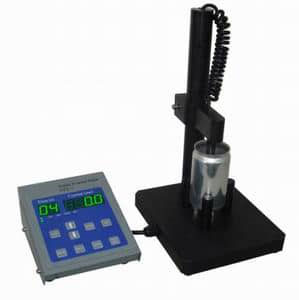
- Lacquer adhesion test: In this test, which is done to determine the adhesion status to the body of the sheet, mark an area equal to one square centimeter of the lacquered sheet, draw a line on it with a razor or a needle with mm2 distances so that the lacquer is part of the lines. It is separated and then glued - test to determine the amount of varnish: To perform this test, the varnished sheet is cut into squares or rectangles with specific sizes and then weighed with a precise balance and the difference between the initial and secondary weights of the varnish in it. A certain level is obtained and by converting it to a unit level, the amount of lacquer is obtained at that specific level. It is natural that the more accurately this experiment is performed, the closer the calculated lacquer will be to the actual lacquer. - Lock uniformity test: This test can be done visually and with a magnifying glass. In this way, the varnish on the sheet should be one-handed and not strong and weak, ie it should not be wavy, which can be recognized by its appearance. 5 - Test for the presence of unblocked spots: To perform this test, mix 700cc of distilled water and 80cc of concentrated hydrochloric acid and 200g of copper sulfate well and apply a cotton ball soaked in the solution on the surface of the cleaned sheet or can so that the membrane of the famous solution Apply copper sulfate on the varnish and if part or parts of the sheet become red, it indicates that the surfaces are not varnished. To test the varnish inside the cans, fill the solution in a small container and empty the solution after 5 minutes. Untreated varnish should be inspected, which can be inspected by a magnifying glass for all varnished spots. If parts are seen as red spots, it indicates that the varnish or spots have not been varnished. 6- Varnish stability test against acids: To do this test, cut a part of the surface of the sheet or can and take it in the form of a square or rectangular cube and put it in a solution of 2% boiling citric acid and leave it for half an hour. In this case, the effects of corrosion, discoloration, blisters and tears should not be observed in the varnish Be. 7- Lacquer stability test against sulfur: To perform this test, a part of a can or sheet is shaped (explained in paragraph 6) into a mixture of 1. Gelatin, sodium chloride, 1. / Sodium sulfate whose pH is acetic acid 7 . 3 Or tartaric acid reaches ten and they put it on for about a week, after which time they evaluate the changes in the inside of the can or sheet. 8- Impact test (or impact to the varnish): In this experiment, cut a piece of the tested sheet into a long rectangle and bend it in the middle around an approximate bar with a diameter of 8mm so that the varnished part is on the outer surface of the sheet. Then, with a special mechanical device, by bending a blow to one side, which has a diameter of 8mm, it will be completely glued and flat, and the other part of the sheet will remain in the same shape with a diameter of 8mm. Immersion in copper sulphate liquid will be determined. 9- Coupling: In this experiment, a piece of lacquered sheet is cut into squares and is fixed by a special mold that presses the sheet and digs it in the form of a cup, and for each sheet, the pressure and the hole are fixed. The sheet is coated and then immersed in copper sulfate liquid and the varnish of any sheet that is less prone to spillage or cracking. It has an advantage
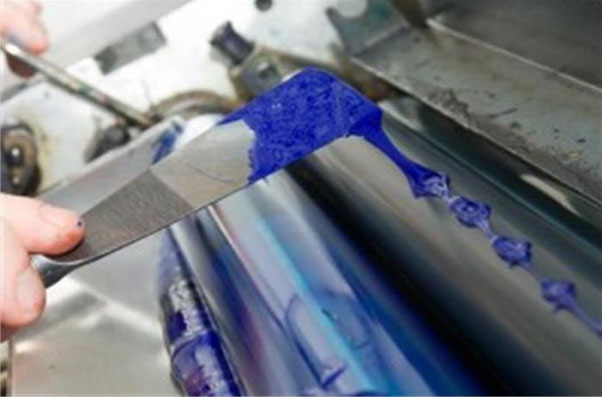
Print on cans:
Due to the faster separation of paper labels containing the information required by the labels (from the body of the cans or the possibility of cheating and moving the paper labels, the desired information such as writings, photos and advertisements can be printed on the body of the cans in different colors). . Printing is done on the initial sheets of cans so that first the outer surface of the sheets is covered with a layer of resinous material or any other suitable printable material known as co-ting, then the designs and writings in a few. The stage is laid by the zingers on the co-ting, then covered with another layer of varnish and baked and fixed in the oven.
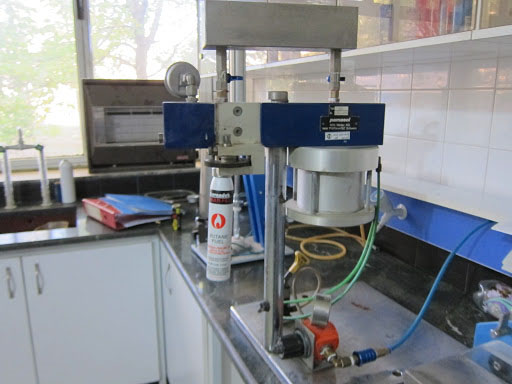
Sheet printing tests:
Printing on cans is not required because it does not come into contact with food inside the cans. It does not require lacquer tests. The type of products in their cans should be exposed to the heat and pressure of the autoclave as much as needed to sterilize the heat and pressure of the autoclave, and the stability of the colors, text, and photos should be determined. In addition, in all stages and operations of making cans, printing should not be separated from the sheet or cracked or cleaned.
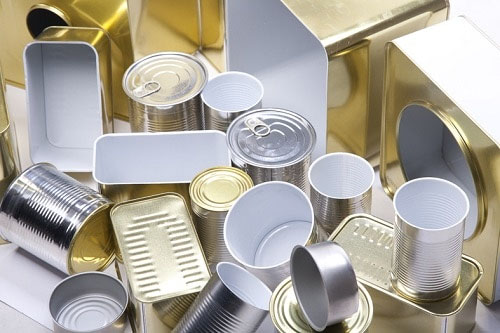
Types of cans
Metal cans come in a variety of shapes and sizes. The most common food cans are round cylindrical cans, which are expressed in two sizes of diameter and height, which consist of a body and at the end, in which the body seams are closed in the form of double seams, so-called cans. Three pieces are famous. But cans that have different shapes of rectangles, ellipses, triangles, etc. are expressed in three sizes: length, width, and height. Another type of can is made up of two parts, the body and the door, in which the body and the bottom of the can are integrated, and the door is double-sealed, which is called a tensile or two-piece can. Also, in some cases, for the convenience of opening the lid of the can, whether it is a three-piece or two-piece can (stretch), a tool has been installed in the lid of the can, which is for easy opening of the can, and this can is called Eeasy open can. And there are grooves on the body and lids of the cans to increase the resistance of the cans to internal pressure and indentation of the cans (during sterilization and cooling of the cans). The numbers indicating the cans include: The first number indicates the diameter of the can and the second number is the height of the can. In most international standards, the dimensions are expressed in inches, while the correct number in inches and the second and third numbers are expressed in 166 inches. For example, a can with dimensions of 4018206 indicates that the diameter of the can is 4 and one sixteenth inches and its height is two and six sixteen sixteen inches. Methods of making cans The body of cans is welded by the method of welding seam: sheets that have already been varnished and printed for printed cans are cut to a much smaller size, mainly by rollers - cut and length and width. The initial sheet of the can body is prepared. The sheets are then cylindrical with wicker or roller machines and the two edges are stacked. The sheets are welded lengthwise with advanced spot welding machines that perform longitudinal welding with special pulleys and copper conductor wires. In this case, the body of the can or so-called cylinder or body body is formed. In the canning industry, in order to make the body of tall cans more resistant to internal and external pressures on the can, by creating grooves and forms on the body of the can, which is called willow, an attempt is made to increase the resistance of the can. Willows are more resistant to sterilization and pasteurization and cooling of cans. The body of soldering iron cans: In the food industry, soldering cans have become a welding seam technology. However, it is made in such a way that after cutting the initial sheets of these cans, which have a longer length than the original sheets of welded seams (of the same size) due to the connection of their body seams, the two ends of the sheets are bent. The rest of the steps are rolled and the two parts L of the body are involved with each other. The parrot is punched by the punching machines and takes the shape of the diameter of the can. Then, for complete sealing and creating more resistance for the can body, The connection of the two ends of the sheet is made, which is done in several steps. Disadvantages of this can include the low efficiency of sealing by tin - lower pressure tolerance - disruption in the sewing of the head and floor due to the seven layers of sewing in the body seam and the consumption of more sheets than the same size seam cans. Food cans are highly sensitive, and controlling each step of their production process is of particular importance that must be done continuously. Tests and controls of the body of the can: 2- Testing the dimensions of the non-rolling primary sheet of cans (length, width and ear to ear) 2- Testing the inner diameter of the can with accurate and special measuring devices for testing the diameter of the can (Diameter) 1- Head and bottom welding of body welds (edge differences) 4- Test of weld seam resistance or can of solder against separation 5- Appearance welding test such as weld welding, welding burns, edge Welding, Welding Weakness 6 - Apply all the steps of varnish testing for varnish or internal varnish. Stretch cans or two pieces These cans, as the name implies, are produced by traction, so that the cans are made by forming, cutting and arranging molds. It is shaped like a can with impact and pressure and only needs a door. The consumable sheets of this type of cans should be stretchable and softer than the sheets of children's boiling cans. Also, one of the most sensitive parts of this type of cans is the internal varnish, which is exposed to breakage and cracking of the varnish due to pressure, impact and traction. The varnish of this type of cans is special, but the best method of varnishing these cans is Spray after can. (More details on stretch and soda cans will be published in future collections). Bottles and bottom of cans: The top and bottom of three-piece cans or the lids of stretch cans are mostly similar, except in special cases. In simple types, they are Easy Open (all key openings). In the simplest case, only in some cases the shape of the protrusions and depressions of the doors is different due to the spring and more resistance of the doors to the pressure of sterilization and cooling of the cans, which prevents the formation of peak peak, which is relative to the diameter. And the volume of the can is different. The doors are made in such a way that first the lacquered sheets are prepared by presses with special molds and the edges of the outer parts of the doors are shaped inwards. And the bottom of the can is injected with a certain amount of rubber (mastic) liquid to the inside of the rotating door. It dries and the amount of rubber liquid drying should not be dry or hard due to the fact that the operation of the door or floor of the can is easier and complete abrasion or in the form of tests related to the head and bottom of the cans: The tops and bottoms of the cans should be within the standard range in terms of dimensions and technical specifications. The doors should be completely uniform and not corrugated, and this experiment can be understood by placing a number of doors on their uniformity and uniformity. Doors should not have brittle lips (due to the small part of the initial cut diameter specified at the edge of the door) or bruising on each part of the door. There are special stencils for controlling all dimensions of doors, which can be used to control and maintain almost all manufactured doors with the help of stencils in the standard range. The rubber liquid (mastic) of the doors must be uniform and free of any debris and dried in the oven. So that it is not smooth, does not clean quickly and is not dry and brittle, and has soft rubber washers. The amount of liquid rubber injected on the doors can be tested in two ways. One before production and the other after door production. Prior to production, it is necessary to first weigh and mark the number of unopened rubber liquid doors with precise scales, and to put them in the production line. After injecting the rubber liquid and drying it, the weight differences are re-weighted. Primary and secondary are the amount of rubber used. In the second case, weigh a few ready-made doors, then clean and rinse the door with the available mastic ammonia solution, then dry and weigh. The difference between the primary and secondary weights indicates the amount of liquid rubber used. If the weight of the rubber liquid is low from the sealing part [10:22, 01/07/2020] Tanaz: The bottom of the can will cause leaks and pores, and the amount of rubber liquid, according to the recommendations of rubber liquid manufacturers, which the importance of consumption and degree of cooking and the required concentration, the importance of sewing or sealing metal cans is the most important step in manufacturing. And it is production that, if not done properly, can have adverse effects on products. As mentioned in the introduction, these food products are part of the national capital, but with an incomplete closure and poor control, in addition to the loss of food products and the loss of the efforts of all those who have somehow interfered in the production of canned food. And, hurting manufacturing companies, and more importantly, an incomplete stitch will cause negative publicity against the food industry. Unfortunately, some companies do not pay much attention to the sealing of cans, despite the above, and even think that with one adjustment or replacement of the necessary parts, the sealing devices will work without problems for several months, but the possibility of any withdrawal from the adjustment due to pressure It is caused by the production and breaking of a part of the machine and the opening of a screw or nut, which in some cases is not recognizable as the appearance of defects and there is a possibility that even one hour or hours of production will be done with problems. Therefore, upgrading the scientific level of the operators or forces that are responsible for adjusting and troubleshooting the sealing devices and knowing how the condition of the cans and consumables and the necessary parts for the correct sealing of the cans and the necessary settings in any kind of cans are the same. The can is unavoidable and should be a priority. At the same time, the technology of this industry is developing day by day, and even the domestic manufacturers of cans have reduced the thickness of the sheets used in cans due to saving foreign exchange and reaching new technology, and have increased their resistance. Sewing micro One of the new designs for floor and door stitching in three-piece cans is called Microseam, which is being used by Keramer in Brazil to save on consumables. The can is designed and recently presented at the International Tin Conference by the Brazilian Institute of Technical Research (ITAL). The designers of this new system claim that they save 14.5% and reduce the cost of consumables. Save $ 66.7 per thousand cans). The thin seam method is basically the same as other conventional door sewing methods, except that he is in this sheet design | Consumption for doors and body must be 16.0 mm. Second, the physical dimensions of door sewing (body hook, door hook and sewing height) have been reduced by up to 50% compared to the current standard sizes. As a result, more beautiful appearance of the new delicate sewing design after complete and varied experiments such as non-destructive tests in different conditions and environments, vibration and vibration tests for transport resistance, floating in chemical solutions, vacuum testing, Biological tests and resistance to bacterial growth have been licensed for use in the food industry. Now, with these explanations, he realizes the importance of improving the scientific level of technical people in food industry companies, and the more information they have, the better they can investigate and solve problems. Familiarity with metal floor sewing (double sewing) In the early days of the canning industry, sealing was done by soldering the top and bottom of the can by soldering. This method became a simple sewing machine with the advancement of industry and then double today's sewing. It has been in the form of a fork for a long time (view No. 2) and today it is ground as a mill. (View No. 3) Double stitching: In general in one definition; The hook edge of the body of the can and the edge of the lid of the can are sewn together and pressed so that the rubber between the hooks completely seals the seam between them. In two stages, it is done by special sewing machines called Fars, Darband, Wallace or Seamer, which is done manually, semi-automatically or completely automatically. One stitch includes the depth of stitching, the thickness of the stitch, the length of the stitch, the length of the door hooks and the body of the can, and the thickness of the door leaf and the body of the can. Sewing the first step or the first step: The pedal (bottom disc) presses the can so that the can and the door are controlled by the pedal spring pressure with the upper disc. After holding the can and the door by the upper and lower discs, the first action pulleys start rotating around the door and the can. At the same time, they approach the door, which is commanded by special cams, and puts pressure on the door and the can, which also causes the pulleys to rotate. They take the shape of a stitch that covers the hook of the hook. The angles and shape of the spools of the first operation are such that the so-called edge of the door and the edge of the box are woven together and the hook of the head and body is formed. Page 71 image Sewing the second step or the second operation: In sewing the first stage, hooks are formed and the door and the can are held together, but the complete sealing has not been created yet. The second operation pulleys approach the door and the can and press these hooks, and finally cause complete sealing. It is sewn that after this stage, the can is also resistant to internal and external pressures (the pressure is the same pressure that is applied to the can by the heat of the product inside the can after sealing due to disinfection, which is due to expansion and It even turns into liquid vapor inside the can. A lot of pressure is applied to the inside wall of the can, and the can is slightly inflated. Sewing the first step or the first step: The pedal (bottom disc) is pressed into the can so that the can and the door are controlled by the pedal spring pressure with the upper disc. At the same time, they approach the door, which is commanded by special cams, and puts pressure on the door and the can, which also causes the pulleys to rotate, and as a result, this pressure and rotation between the door and the hook box enters and They take the shape of a stitch that covers the hook of the body hook. The angles and shape of the spools of the first operation are such that the so-called edge of the door and the edge of the box are woven together and the hook of the head and body is formed. Page 71 image Sewing the second step or the second operation:
Sewing the second step or the second operation:
In sewing the first stage, hooks are formed and the door and the can are held together, but the complete sealing has not been created yet. The second operation pulleys approach the door and the can and press these hooks, and finally cause complete sealing. It is sewn that after this stage, the can is also resistant to internal and external pressures (the pressure means the same pressure that is applied to the can by the heat of the product after sealing due to microbial depletion due to the expansion of the product. It even turns into liquid vapor inside the can. A lot of pressure is applied to the inside wall of the can, and the can is slightly inflated. It is used in such a way that first the can with the lid on it is placed manually on the pedal plate of the device and then by using the pedal pressure by the manpower of the can and the door by the pedal to the upper disk (according to) It sits and begins to rotate (rotation is done by the rotating force of the disc) then with the long arm embedded in front of the device on which the two pulleys are placed. Close the rotation and then the spool of the second operation is done, thus finally closing. Due to the sewing by the arm force of the operator, such seals cannot have the uniformity and complete sealing of all sealed cans. In such devices, the rotating cans and pulleys are fixed but rotate by rotating the position around their axis
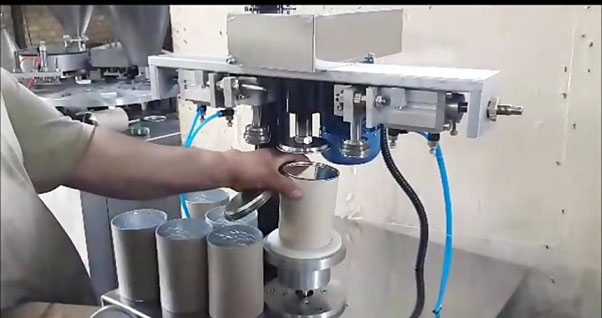
Pedal semi-automatic closing devices:
Such devices start the closing operation by pressing the pedal of the device and by removing the pressure from the pedal, the closing operation will end and the other closing is subject to re-pressure on the pedal of the device (by the foot pressure force of the operator of the device). This device has a cap (head) that by placing the can with the relevant door manually on the pedal of the device and then by pressing on the pedal of the device, the can and the door sit on the upper disk, then the reels of the first operation begin to perform the first operation and so on. From those second action pulleys, the second operation begins, and finally the can is detached from the top disc and the operator can remove the sealed can. In the above device, the can and the upper disc and the pedal are fixed, and the pulleys, in addition to the positional movement (around their axis), approach the can and rotate around the can, completing the closing operation and returning to the first state. Such devices are not responsible for the increasing production of food companies with the industrialization of today's societies in the mass production of companies and in addition due to their pedality and the direct relationship between body hook in sewing and pedal pressure of the devices and the pressure by force. Human is provided. The possibility of reducing or increasing foot pressure is inevitable, as they are less efficient than automatic devices.
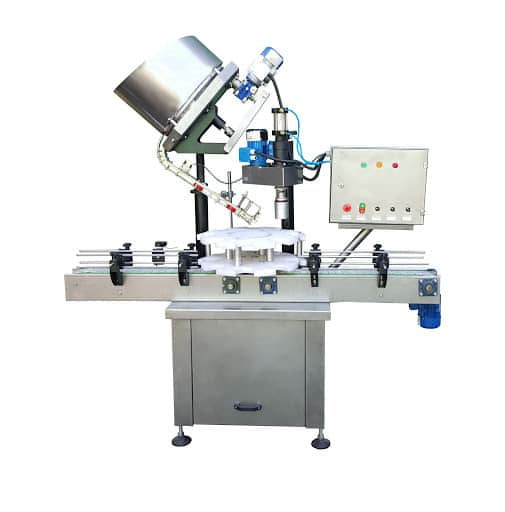
- Single-stage automatic closing devices
These devices, including (single-head, triple-head, four-head, five-head and six-head), are almost considered modern devices. Sealing operations have the following differences: | 1- Device with fixed box (four pulleys) and revolving pulleys 2- Device with revolving cans and fixed pulleys (two pulleys) 2- Automatic sealing device with fixed box characteristics and four-wheeled revolving pulleys) In such devices, after transferring the lids and cans and setting them and sitting them on the top disc by the pedal (which is the same in most automatic devices), the cans and doors are fixed and the cap has a rotating motion, which mainly has four pulleys per capita. (The first two operation rollers are the second two operation rollers). They rotate and under the same pressure complete the first operation, then the second operation, and finally the sealing operation is completed, and the can is transferred out of the sealing device by special guides, and this operation moves the reels forward and backward. Compared to cans with camels embedded in each hat that is transferred to the pulleys by arms and shafts. Two-stage automatic closing device In two-stage devices, first the can and the door are seated once by the pedal pressure of the upper disc and the first operation is performed, then it is separated and transferred to another part of the device by the conduction channels and there it is seated by the pedal pressure to another upper disc. It is done and the cans are sealed, in which the door and cage transfer systems are not much different from the newer devices, only because they have two stages, they have a lower efficiency than the automatic one-stage devices. In addition, due to being two-stage, more parts have been used in this device, which causes more parts to wear out, and as a result, the costs of repairing and replacing higher parts are higher than single-stage devices, and the sealing operation is less efficient. . Page 83 image Two-stage sealing devices also have two mechanisms: 1- Fixed cans and rotating pulleys 2- Rotating cans and fixed pulleys. After introducing the mechanism of sealing devices, it is possible to divide the types of automatic sealing devices in this industry into one to six heads in general. Due to the high circulation of their products, the flooring machines of the canning companies are also eight heads, which is the newest type of flooring for three-piece cans, which is called the canomat machine, which is multifunctional, including parting, forming, and flinging. And Simer, which is the bottom of the can. In other words, with a general view, it can be seen that four types of devices are embedded in a device with high efficiency, and the simmering part of this device does not have a pulley, but a rotating can and the profile of the pulleys is embedded in a crescent-shaped environment. The effect of rotating the can and dealing with the crescent-shaped profile part of the curing operation is done in the first and second steps. Figure 83 Automatic devices all have a fixed mechanism and similar parts, only the volume of their production is different, which is determined by the number of clogs they have. Automatic one-head locking devices in a work course, ie starting to separate a door and a can and transferring it to the helmet, and after sealing and separating the box from the helmet, a work step is performed, then the next box starts to be locked, but in Multi-head devices This operation is performed consecutively by multiple heads, and of course multi-head devices have a larger production volume than single-head devices, because single-head devices will not be transferred to the pedal until the end of the sealing operation. Closing is completed and the next can is started, but in multi-head devices, when one can and door is being closed, another door and can are transferred to another pedal and begin to close, so that in one course they can be compared. The number of heads of the device has a higher production volume. Introducing the main parts of an automatic door closing device 1- Canner feeder 2- Door feeder ٣- Door and canal movement channels 4- Rollers and pedals 5- Cans outlet channels - Cans feeder The design of automatic locking devices is as shown at the beginning of the input Ga, the spiral shaft is embedded with a variable step, in which the input cans are connected to the device. Each of them is separated and transferred to the pedals of the device by the transfer stars so that a can is separated from the input part. Only a certain pedal is instructed, which in some devices is done by chains and finger rings. From the separation of the can from the inlet of the device to the pedal Data should be checked so that the cans are not hit and damaged due to excessive, open or narrow channels. The door was also updated with twenty, which was stimulated by the movement of a can of feeder door and a door was separated for the desired can. After transferring the door by special fingers on the guide rails, the door is finally centered with a can and placed on the center of the pedal, otherwise all parts of the transfer must be adjusted and controlled. In all stages of door separation and transfer of the door on the can, the slightest blow or damage should not be done to the door, otherwise the closing device will act incompletely. The can was stimulated to separate the door and after moving the door, it visited all the mentioned routes. If there is any damage to the door in the mentioned parts, it will be clear that it is possible to take action to eliminate the defects and also do this on. The body of the can can be tested. Important points in the general preparation of simmers: Before the regulator starts working on the simmer. He must make sure that he can turn the device away from danger and he must observe the following points: This collision prevented. Metal tears and any obstructions. 3. The pedal must move freely. 4- The pulleys should rotate freely and without getting stuck or released and should be continuously checked for excessive wear or damage or wear of the bearings. Be. 5. Knock out rodds should move freely The correct and simultaneous timing relationship between pedal movement and throwing movements should be Review. 6- Time setting: (time and place) between the first and second action pulleys and adjustment The mechanisms of entering the cans and feeding the doors and adjusting them with each other and the pedal should Review. 7- The end of the steering wheel cam should be checked for wear and wear The connection between the camshaft and the bearings of the power transmission arms to the pulleys must be ensured, and to prevent wear and tear of the cams, the arm bearings must be constantly checked so that they do not get stuck and rotate freely. 8- Cleaning the space between the tip of the door separator blades (feeder door) and the end screws of the door feeding pipe section should be constantly checked and should never be marked on the doors with the hit hand at the operating speed of the door feeding. 9 - Lubrication, grease work and cleaning should be done regularly and carefully all in accordance with maintenance instructions. 10. The setup principles are the same for SIMs that do not use conventional pulleys, but you should refer to the device's manual to know the details of the recipe. Metal tears and any obstructions. 3. The pedal must move freely. 4- The pulleys should rotate freely and without getting stuck or released and should be continuously checked for excessive wear or damage or wear of the bearings. 5. Knock out rodds should move freely, and the correct timing relationship between pedal movement and protrusion should be considered. 6- Setting the time: (time and place) between the first and second operation pulleys and adjusting the mechanisms of entering the can and feeding the door and adjusting them with each other and the pedal should be checked. 7- The end of the steering wheel cam should be checked for wear and the connection between the cam and the bearings of the power transmission arms to the pulleys should be ensured and to prevent the wear of the cam, the arm bearings should be constantly checked so that they do not get stuck and rotate freely. 8- Cleaning the space between the tip of the door separator blades (feeder door) and the end spirals of the door feeding pipe section should be constantly checked and should never be marked on the doors with the hit hand by the operating speed of the door feeding. 9 - lubrication, greasing and cleaning should be done regularly and carefully all in accordance with maintenance instructions. 10. The setup principles are the same for SIMs that do not use conventional pulleys, but you should refer to the device's manual to know the details of the recipe
References
Engineer Alireza Osanloo
processing. UK: Blacki Academic and Professional, 279 p. 40- Arthey, D. and P.R. Ashurst. 1996. Fruit processing. UK: Blacki Academic and Professional, 248 p. 41- Aylward, F. 2001. Food technology processing and laboratory control. India: Agrobios, 303 p. 42- Barret, D. M. ; L. Somogyi and H. Ramaswamy. 2005. Processing fruits, science and technology. UK: CRC press, 841 p. 43- Bhatia, S. C. 1994. Canning and preservation of fruits and vegetables. India: Siri, 208 p. 44- Dauthy, M. E. 1995. Fruit and vegetable processing. FAO agricultural services bulletin, 382 p. 45- Fellows, P. J. 1990. Food processing technolngy, principdes and practic. England: Ellis Horwood limited, 505 p. 46- Finch. C. and H. Cracknell. 1998. Food preparation and cookery. Malaysia: Addison Wesley Longman, 516 p. 47- Footitt, R. J. and A. S. Lewis. 1995. The canning of fish and meat. UK: Blacki Academic and Professional, 310 p. 48- Frazier, W. C. 1995. Food microbiology. New york: McGraw Hill, 539 p. 49- Gould, G. W. 1995. New methods of food preservation. UK: Blackie Academic and Professional, 324 p. 50- Govindan, T. K. 1985. Fish processing technology. India: Mohan Primlani, 252 p. 51- Graf, E. and I. Sam Saguy. 1991. Food product development, from concept to the marketplace. USA: Van Nostrand Reinhold, 441 p. 52- Gupta. G. and V. K. Narang. 1999. Modern food and food products industries. India: Small industry research institute, 504 p. 53- Houston, D. F. 1972. Rice chemistry and technology. USA: AACC, 517 p. 54- Hummel. C. 1966. Macaroni products, manufacture, processing and packing. UK: Food Trade Press, 287 p. 55- Jagtiani, D. 1980. Fruit preservation. India: Tarang Paperbacks, 104 p. 56- Jay, J. M. 2005. Modern food microbiology. UK: Springer, 790 p. 57- Jongen, W. 2002. Fruit and vegetable processing, improving quality. UK: CRC press, 388 p. 58- Juliano, B. O. 1985. Rice chemistry and technology. USA: AACC, 774 p. 59- Khatkar, B. S. 2007. Food science and technology. India: Daya, 549 p. 60- Lopez, A. 1987. A complete course in canning, book II: processing procedure for canned food products. USA: Canning trade Inc, 473 p. 61- Luh. B. 1975. Commercial vegetable processing. AVI Publication Inc, 755 p. 62- Martin, R. E. 1990. The Seafood industry. USA: Van Nostrand reinhold, 445 p. 63- McCabe W. L. ; J. C. Smith and P. Harriott. 2001. Unit operations of chemical engineering. USA: Mc Graw Hill, 1114 p. 64- Potter. N. N. 1995. Food science. USA: AVI Chapman and Hall, 608 p. 65- Ranken, M. C. and R. C. Kill. 1997. Food industries manual. UK: Blacki Academic and Professional, 650 p.166- Rogers, J. L. 1974. A course in Canning. Food Trade Press Ltd, 125 p. 67- Sethi. M. and S. Rao. 2001. Food science experiments and application. India: CBS publication, 234 p. 68- Shakuntala Manay, N. and M. Shadaksharaswamy. 2001. Food, facts and principles. India: New age international Publishers, 540 p. 69- Lal, G. ; G. S. Siddappa and G. L. Tandon. 1998. Preservation of fruits and vegetables. India: Indian Council of agricultural research, 488 p. 70- Srilakshmi. B. 1996. Food Science.India: New age international limited Publishers, 375 p. 71- Subbulakshmi, G. and A. Udipi. 2001. Food processing and preservation. India: New Age International Limited Publishers, 298 p. 72- Toled, R. T. 1991. Fundamertals of food process engineering. USA: Chapman and Hall, 602 p. 73- Zeuthen, P. and L. Bogh-sorensen. 2003. Food preservation techniques. UK: CRC Press, 581 p
- Service ProvidersBandar Food Industry Knowledge Group
- DateJune 30 2020
- Grouping News and Articles
- Source linkwww.BandrFood..ir
- Subscribe




